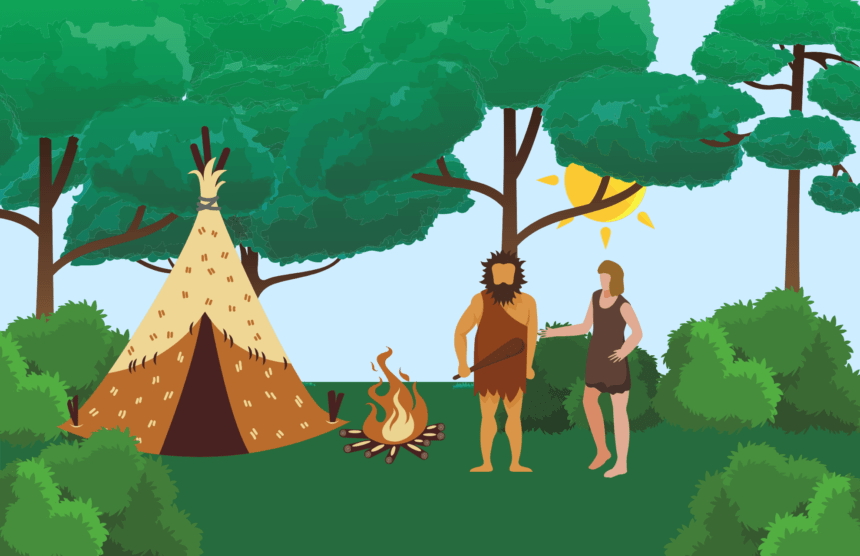
The diet of early humans: Hunters & Gatherers
The life & diet of early humans: Hunters & Gatherers
Hunters and gatherers: a society of early humans living in a way where their diet consisted obtaining food through foraging began over five million years ago”. Best to keep in mind that there is no set date of when early humans or “hunters and gatherers” first walked the Earth. It depends on what homo species someone believes first began expressing characteristics and actions that are recognized. Therefore, due to little evidence and recorded history, the time of the “first” early human is subjective. The above definition will be the one referred to when speaking about hunters and gatherers.
Early humans or hominins, originated from South and East Africa before expanding and mirgrating toward Asia and Europe. As early humans traveled across Asia and Europe, they slowly advanced from using simple tools, such as stones or sharpened sticks, to using fire and creating hand-axes, spears, bone tools, fishhooks, the bow and arrow, and the harpoon. These advancements improved quality of life by increasing diet options and advanced their clothing and shelter options.
Diet of Early Humans
Evidence shows humans started off vegetarians and later added meat to their diet. The progression was due to the advancement of tools and fire. Early humans ate fruits and grasses, then nuts and seeds before progressing to scavenging for meat. When the tools advanced, early humans switched from scavenging to hunting animals.
Diets of different groups varied with each region.
The diet of the Arctic Intuit was 99% seals and fish with little vegetation due to the harsh climate. The Hadza people of Tanzania have a more starchy diet that includes meat, berries, tubers, and their most energy-dense food-honey. The Siberian Yakut people ate mainly fish, horse, and wild game, while the Bajau of Malaysia were deep-sea divers that ate mostly from the sea. Natives to specific areas have evolved due to the unique diets the environments provided. The Bajau people are believed to have abnormally large spleens that help provide enough oxygenated blood whild hunting underwater3.
Meanwhile, studies show when hunter and gatherer groups switch to the western diet, more diseases appear, regardless of the group. According to paleoanthropologist, Peter Ungar of University of Arkansas, “ A lot of people believe there is a discordance between what we eat today and what our ancestors evolved to eat.” The evidence in the lack of diseases seen in traditional hunter-gatherer groups is one of the reasons the Paleo diet has gained popularity in recent years as well.
The paleo diet, also known as the caveman diet, primarily uses foods that can be obtained through hunting and gathering and not through farming, such as lean meats, fruits, and vegetables. It eliminates all dairy products, legumes, and grains1. It is believed that humans have only evolved far enough to only be able to consume foods on any diet recorded before the Neolithic Age, or the farming revolution. This also raises the question, “Is there a downside to the advancement of farming?”
Evidence
Paleoanthropologists analyze fossils, bones, and use reverse-engineering to study diets. This has helped tremendously in understanding the lives of early humans.
Evidence suggest that human anatomy had a very long digestive system used to break down plants and convert it to usable energy. The introduction of animal protein to the diet evolved human antomy. Resulting in a shorter digestive system due to requiring less digestion than compared to plants. There is reasonable evidence that the loss of the gut resulted in the body using these extra calories to increase brain-size, which furthered our advancement as well. Also, hominins developed changes in height and build of the body as well as dentition; a factor used in determining the diet related to the characteristics and arrangement of teeth. For example, thin tooth enamel is associated with a high fruit diet. Additionally, more cooking and eating softer foods caused the large jaw-size humans once had to diminish over time, resulting in the elimination of the back molars/wisdom teeth.
Over time, the early nomadic humans from Africa, Europe, and Asia have adapted to using different food-finding methods based on the availability of the land and advancements in technology. Technology greatly improved in the Neolithic age when we began building semi-permanent homes, domesticating animals, and cultivating farms.
Though these were significant advancements and necessary to the population growth, how did it affect our overall diet?
Is the diet of the hunters and gatherers, now known as the paleo diet, the ideal diet for the early humans?
How will farming further change our diet?
References
1) Gibbons, Ann, and Matthieu Paley. “The Evolution of Diet.” National Geographic, www.nationalgeographic.com/foodfeatures/evolution-of-diet/.
2) History.com Editors. “Hunter-Gatherers.” History.com, A&E Television Networks, 5 Jan. 2018, www.history.com/topics/pre-history/hunter-gatherers.
3) Paley, Matthieu. “We Are What We Eat: Diving for Dinner With the Sea Gypsies.” National Geographic, 26 Dec. 2017, www.nationalgeographic.com/photography/proof/2014/10/29/we-are-what-we-eat-diving-for-dinner-with-the-sea-gypsies/.
4) Robinson, Jennie. “First Hunter-Gatherers – Oxford Handbooks.” First Hunter-Gatherers – Oxford Handbooks, 17 June 2017, www.oxfordhandbooks.com/view/10.1093/oxfordhb/9780199551224.001.0001/oxfordhb-9780199551224-e-029.
5) “Why Do We Have Wisdom Teeth?” The Smithsonian Institution’s Human Origins Program, 14 Sept. 2018, humanorigins.si.edu/education/fun-facts/why-do-we-have-wisdom-teeth.
